Published
on 2
Sep 2021
|
All rights reserved.
|
|
|
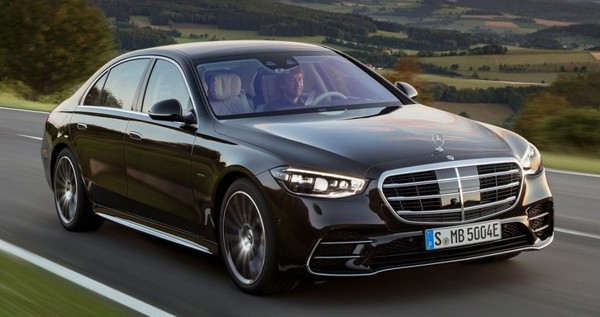
|
|
The
new generation S-class turns its attention to inside...
|
|
Mercedes
S-class has entered another generation, codenamed W223 series. Changes
to the exterior design is pretty progressive. The overall profile is
similar, just a tad sleeker. The classical radiator grille is made
slightly larger and more angular, but aesthetic is slightly damaged by
covering part of the grille with a black plastic panel, which hides
sensors for autonomous driving. The headlamps get slimmer, as are the
now triangular taillights, which mirror the sporty CLA-class. At 5210mm
long, 1954mm wide, 1503mm tall and 3106mm in wheelbase, the new car is
slightly larger in every dimension. Yet that is just the standard
wheelbase model. The LWB version, which accounts for an amazing 90
percent of global sales, is 110mm longer again. Despite the larger
frontal area, Mercedes claims the overall drag is reduced slightly,
thanks to lowering the drag coefficient from 0.24 to 0.22, which is
currently the sleekest in production car as I know.
The W223 rides on an evolution of the existing MRA platform which
debuted in the last S-class. Its chassis construction is again an
aluminum and steel hybrid, but now the aluminum content is lifted to
over 50 percent. Most of the front chassis structure, the suspension
components and almost the entire body shell is made of aluminum, while
the passenger cell is made of steel to provide stronger crash
protection. There is no talk of weight reduction, but comparing
different models with their direct predecessors will find they are more
or less the same.
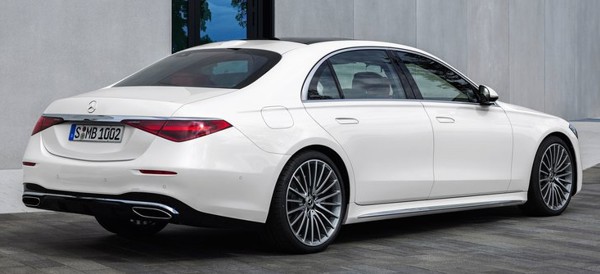
|
|
Cd
0.22 is the sleekest ever on a production car.
|
|
A new feature
is active rear-wheel steering. Apart from the usual enhancement of
high-speed stability and low-speed agility, it is able to steer up to
10 degrees at parking speed, so to enable a short turning radius
matching a compact car. Otherwise, most mechanical designs are largely
carried over, such as the 4-link front and 5-link rear suspensions, the
Airmatic variable air springs and the ADS+ adaptive dampers. The
E-active body control is a rebranded bunch of old features like curve
tilting function, road surface scan and the ability to lift the body
when side collision is anticipated. 4-wheel drive is now made standard
on all models except the least powerful diesel.
As usual, a new generation Mercedes is always launched with existing
engines. These include the M256-series 3-liter petrol straight-6 and
OM656-series 2.9-liter diesel straight-6 that debuted 3 years ago. This
means the S450 and S500 petrol have their 367hp and 435hp offering
unchanged (plus an extra 22hp offered by the 48V mild hybrid system for
short periods). The diesel S350d also keeps its 286hp output, although
the twin-turbo S400d loses 10hp to 330hp due to increased exhaust
aftertreatment required to comply with stricter emission standard. The
only V8 offering in non-AMG line-up is now S580, replacing the outgoing
S560. Its 4-liter motor makes 503hp, up from 469hp, while the addition
of 48V mild hybrid system should help reducing emission a little bit.
Meanwhile, S580e combines the petrol straight-6 with a
transmission-integrated motor for a total output of 510hp, although
carrying 270kg more than the S580 results in poorer performance, but it
provides an EV range of 100km and helps lowering fleet average
emission.
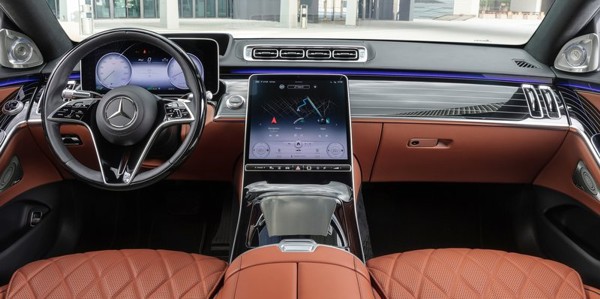
|
|
Sleek
surfaces, large touch screen and free of buttons, the very best
Mercedes cannot escape from the influence of Tesla.
|
|
The interior
design of W223 is a big departure from its predecessor. Not only it has
abandoned the twin-TFT instrument arrangement for a Tesla-style
portrait center touchscreen (11.9-in as standard, or 12.8-in OLED as
option) and a single 12.3-inch TFT instrument with 3D effect, but the
whole interior design is changed, emphasizing minimalism and free of
buttons. Inspired by yacht design, it uses heavily lacquared flat dash
panels that runs the full width of the cabin, enhancing the sense of
airiness and high quality. LED ambient lights surround the whole cabin.
There are further improvements to the driving aids and MBUS
infotainment system, as well as an HUD feature that displays virtual
arrows on the road ahead, but these are just to be expected from a new
Mercedes flagship. More gimmicky is the optional flush door handles,
which pops out automatically when the driver approaches or touch it.
Yes, even the very best Mercedes cannot escape from the influence of
Tesla.
On the Road

|
|
Rear
passengers are better taken care than ever.
|
|
The new cabin is amazing for its digital technology and Sci-Fi feel.
Materials and build quality are also of very high standards, although
not quite in the league of Bentley Flying Spur. However, while the 3D
effect display and touchscreen interfaces look fancy, they don’t work
as intuitively as conventional dials and buttons. The tilting display
may also reflect sunlight. Cabin space is generous, especially the rear
which affords 16mm more headroom and 24mm more legroom than the old
car.
In driving terms, the S-class remains oriented to comfort, and probably
more so than the last few generations. It is impressively quiet, thanks
in part to adding noise absorbing foams at the C-pillars. The
suspension setup, no matter in any modes, is softer than its Bentley,
BMW and Audi rivals, so that it flows smoothly on most surfaces.
Meanwhile, the rear-steering system gives it outstanding agility at low
speed.
Nevertheless,
in terms of refinement it is not quite in a place to challenge a
Rolls-Royce Ghost. The six-cylinder motor of S500 is a bit too audible
when working hard, meaning you really need the torquier V8 to deliver
the best refinement. Cars on optional 21-wheels may also transmit too
much harshness and noise into the cabin when gliding over broken
surfaces or sharp ridges. These occasional flaws slightly disappoint
those expecting the usual high refinement standards of the S-class.
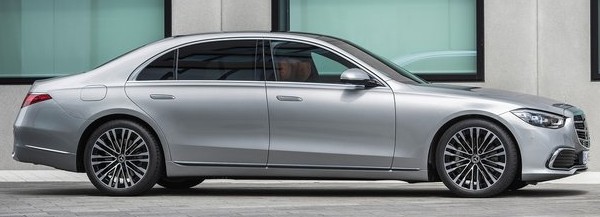 |
|
It's
not a perfect car, but no other mainstream limousines do the luxury job
as good.
|
|
Meanwhile, for
keener drivers, the new S-class fails to keep up with competitors that
have moved on the game of handling. While it is no worse than its
predecessor, it rolls and floats too much beside the fabulous Bentley
Flying Spur, which excels in tight body control and sportscar balance.
In addition to an isolated steering and spongy brake pedal, few would
choose the S-class for driving fun.
As a luxury car, the Mercedes is hard to fault. Although it is not as
flawless as some of its predecessors, no other mainstream limousines
can serve luxury and comfort as good as the S-class. Its fresh cabin
and sophisticated digital technology should give it a strong advantage
in the next few years, at least before BMW 7-Series and Audi A8 are
updated. However, while the S-class used to be the best all-round
luxury car money can buy, the new generation will live under the shadow
of Bentley Flying Spur, a more expensive car but also a true work of
wonder.
|
Verdict:     |
Published
on 2
Sep 2021
|
All rights reserved.
|
|
Maybach S680
|
|
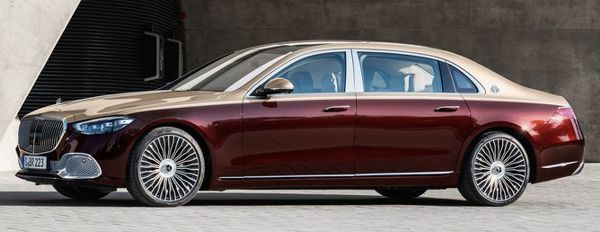
|
|
If
flamboyance doesn't sell on you, think about this: Maybach S680 is now
the only S-class model powered by V12 motor.
|
|
Since last generation,
Maybach was turned from an independent ultra-luxury line to a variant
of Mercedes-Benz models. The new S-class Maybach consists of Maybach
S580 and Maybach S680. They were practically extra-long-wheelbase
versions of the S-class. However, at least the S680 is served with an
exclusive engine which is no longer available to the mainstream
S-class. Yes, it is the long-serving Mercedes 6-liter V12, still using
single overhead camshaft and 3 valves each cylinder. Strangely,
although the badge is upgraded from S650 to S680, its output is
actually detuned from 630hp to 612hp, while peak torque gets a similar
drop from 737 to 664 lbft. On the plus side, the V12 is now mated with
4-wheel-drive, 9G Tronic transmission (instead of 7G Tronic) and
supported with EQ-boost mild hybrid technology. The car can go from
rest to 60 mph in 4.3 seconds, not bad for one weighing 2.3 tons.
Both Maybach S-class models ride on a massive 3396 mm wheelbase, 180mm
longer than the LWB S-class. Unlike the mainstream model, their rear
quarter windows are fixed at the C-pillars rather than the doors, so to
enable better insulation of noise. Besides, additional foams are
inserted in the rear wheel arches to absorb noise. There are also
thicker laminated rear windows, quiet tires and anti-noise audio to
lift its refinement beyond the regular S-class.
Outside, you can spot the Maybach from its flamboyant grilles and
bumper intakes, the Maybach logo at C-pillars or in most cases,
optional 2-tone paint scheme. Inside, the extra wheelbase is put to
good use by employing airliner-style reclining rear chairs, which have
integrated leg rests. The front passenger seats can slide forward
automatically to free up more space to the rear. There are also folding
tables, a refrigerator and champagne flutes, besides the usual
infotainment system for the rear occupants.
Unsurprisingly, the Maybach rides even smoother than the LWB S-class,
while trading some agility and poise. Handling or driving engagement
are not very important to this kind of cars, as they are all driven by
chauffeurs while the boss sitting at the back. To most of us, the
£200,000 limousine is superfluous, just like a Rolls-Royce
Phantom, which is twice as expensive again. However, since the new
Maybach strategy started in 2015, sales have surged by multiple times
while development costs are down. It is a successful turnaround.
|
Verdict:     |
Published
on 30
Jun 2023
|
All rights reserved.
|
|
AMG S63 E-Performance
|
|
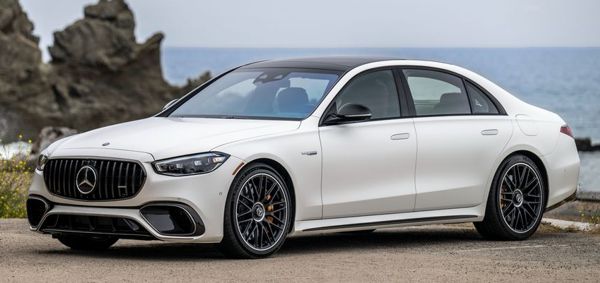
|
|
Electrified
to over 800 hp, is it really what AMG fans looking for?
|
|
The AMG version of S-class
follows the footprints of GT63 and C63 to adopt electrified powertrain
with “E-Performance” moniker. This means a plug-and-play module called
EDU (Electric Drive Unit), which consists of a 190hp motor, a 2-speed
gearbox and an electronic LSD, are put at the rear axle and topped with
a liquid-cooled battery pack. While the batteries on lesser
E-Performance models measure only 6.1 kWh, this one is enlarged to 13.1
kWh, giving a longer (but still modest) zero-emission range of 33 km
(20 miles) on WLTP cycles. Up front, the S63 keeps AMG’s 4-liter
twin-turbo V8, serving 612 horsepower and 664 lbft of torque to the
4matic+ drivetrain via the division’s 9-speed MCT gearbox. Total output
is 802 hp and a staggering 1055 lbft of torque (strangely, the latter
is more than the summation of both power sources, probably due to
different gearing), enabling the S63 E Performance to reach 60 mph in
3.2 seconds while top speed is capped at 180. It goes without saying
this is the quickest S-class ever, though the last generation S63 was
not much slower.
On a stretch of open road, the car is immensely quick, but it is also
undramatic to do so, because acceleration is seamless and the engine
noise is buried by thick insulations. Granted, maximum electric power
is available for up to 10 seconds only, then scaled back to 95 hp to
avoid overheating the battery. However, 10 seconds is a lot of time for
a car accelerating so quickly.
Predictably, the E-Performance hardware adds a lot of weight. To make
the case worse, the S63 is available in only long-wheelbase body. Now
the car tips the DIN scale at just over 2.5 tons, more than a
W12-powered Bentley Flying Spur Speed. To address the weight problem,
AMG threw everything in its arsenal into the car: rear-wheel steering,
air suspension, adaptive dampers, active anti-roll bars, active engine
mounts, E-diff, 4matic+, ceramic brakes…
On the road, the S63 does feel more agile than its figures suggested.
The rear-wheel steering in particular helps tightening its turning
circle at lower speeds, and the active anti-roll function keeps body
motion flat to the extent of artificial-feeling. Firmer calibration of
suspension does rob it the suppleness of the standard S-class, but not
uncomfortable for a performance saloon. Traction from the
all-wheel-drive system is remarkable. More disappointing is the
steering, which is just as light and lifeless as the standard S-class.
On the early test cars at least, the powertrain calibration leaves
something to be desired. There are some occasional driveline shunts in
hard driving due to the hesitation between two power sources or the
gearshift of the 2-speed gearbox. Brake pedal response is also a bit
jumpy. AMG guaranteed these problems will be sorted out before
production, but that doesn’t sound good for a marque that used to
perfectise everything before announcement.
The S63 E-Performance is still a remarkable luxury car. While it is not
exactly a driver’s car, no one else combine luxury (look at that
interior !) with near-supercar performance quite as good as it. That
said, I would have preferred AMG to stick with pure V8 power and save
400 kg. That won’t be much slower or more polluting in the real world,
but definitely better to drive and cheaper to buy.
|
Verdict:     |
|
|
|
|
|
|
|
|
|
|
S400d
4matic
|
2020
|
Front-engined,
4WD
|
Aluminum + steel monocoque
|
| Mainly aluminum |
5179 / 1921 / 1503 mm
|
| 3106 mm |
Inline-6 diesel
|
| 2925 cc |
DOHC 24 valves, VVL
|
Sequential twin-turbo
|
CDI
|
330 hp
|
516 lbft
|
9-speed automatic
|
F: 4-link / R: multi-link
|
Adaptive air spring + damping
|
F: 255/45ZR19; R: 285/40ZR19
|
1995 kg
|
155 mph (limited)
|
5.1 (c)
|
| - |
|
S500
4matic (L)
|
2020
|
Front-engined,
4WD, 4WS
|
Aluminum + steel monocoque
|
| Mainly aluminum |
5179 (5289) / 1921 / 1503 mm
|
| 3106 (3216) mm |
Inline-6, mild hybrid
|
| 2999 cc |
DOHC 24 valves, DVVT
|
Turbo + electric charger
|
DI
|
435 hp
|
383 lbft
|
9-speed automatic
|
F: 4-link / R: multi-link
|
Adaptive air spring + damping
|
F: 255/45ZR19; R: 285/40ZR19
|
1970 (1990) kg
|
155 mph (limited)
|
4.7 (c) / (4.5*)
|
| (11.1*) |
|
S580
4matic (L)
|
2020
|
Front-engined,
4WD, 4WS
|
Aluminum + steel monocoque
|
| Mainly aluminum |
5179 (5289) / 1921 / 1503 mm
|
| 3106 (3216) mm |
V8, 90-degree, mild hybrid
|
| 3982 cc |
DOHC 32 valves, DVVT
|
Twin-turbo
|
DI, cylinder deactivation
|
503 hp
|
516 lbft
|
9-speed automatic
|
F: 4-link / R: multi-link
|
Adaptive air spring + damping
|
F: 255/40ZR20; R: 285/35ZR20
|
2020 (2040) kg
|
155 mph (limited)
|
4.2 (c) (3.9* / 4.0**)
|
| (9.7* / 9.9**) |
|
|
|
|
|
Performance tested by: *C&D, **MT
|
|
|
|
|
|
|
S580e
4matic (L)
|
2021
|
Front-engined,
4WD, 4WS
|
Aluminum + steel monocoque
|
| Mainly aluminum |
5179 (5289) / 1921 / 1503 mm
|
| 3106 (3216) mm |
Inline-6, electric motor
|
2999 cc, battery 28kWh
|
DOHC 24 valves, DVVT
|
Turbo + electric charger
|
DI
|
367 + 150 = 510 hp
|
369 + 325 = 553 lbft
|
9-speed automatic
|
F: 4-link / R: multi-link
|
Adaptive air spring + damping
|
F: 255/45ZR19; R: 285/40ZR19
|
2290 (2310) kg
|
155 mph (limited)
|
5.0 (c) / (4.2*)
|
| (10.1*) |
|
Maybach
S680
4matic
|
2021
|
Front-engined,
4WD, 4WS
|
Aluminum + steel monocoque
|
| Mainly aluminum |
5469 / 1921 / 1510 mm
|
| 3396 mm |
V12, 60-degree
|
| 5980 cc |
SOHC 36 valves
|
Twin-turbo
|
Twin-spark
|
612 hp
|
664 lbft
|
9-speed automatic
|
F: 4-link / R: multi-link
|
Adaptive air spring + damping
|
F: 255/40ZR20; R: 285/35ZR20
|
2275 kg
|
155 mph (limited)
|
4.3 (c) / 3.7*
|
| 8.3* |
|
AMG
S63 E-Performance
|
2023
|
Front-engined,
4WD, 4WS
|
Aluminum + steel monocoque
|
| Mainly aluminum |
5336 / 1921 / 1516 mm
|
| 3216 mm |
V8, 90-degree + electric motor
|
3982 cc, battery 13.1kWh
|
DOHC 32 valves, DVVT
|
Twin-turbo
|
DI, cylinder deactivation
|
612 + 190 = 802 hp
|
664 + 236 = 1055 lbft
|
9-speed MCT
|
F: 4-link / R: multi-link
|
Adaptive air spring + damping,
active anti-roll bar
|
F: 255/45ZR20; R: 285/40ZR20
|
2520 kg
|
180 mph (limited)
|
3.2 (c) / 2.6* / 3.5**
|
| 6.6* / 7.1** |
|
|
|
|
|
Performance tested by: *C&D, **Autocar
|
|
|
|
|
|
|